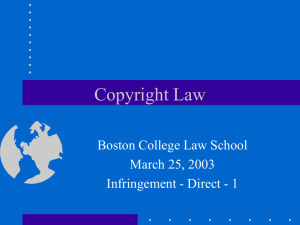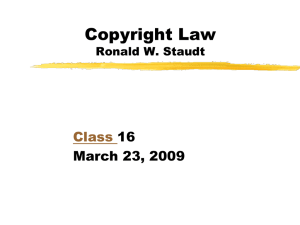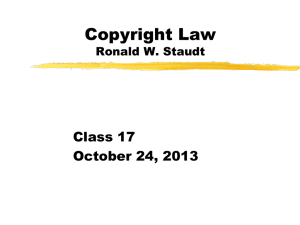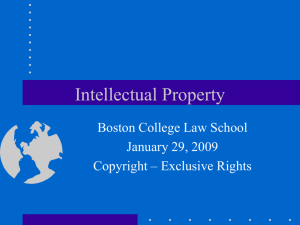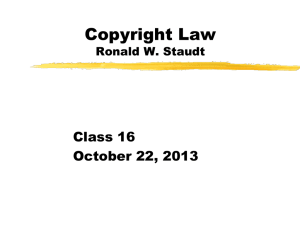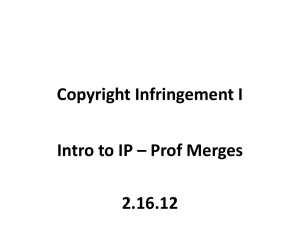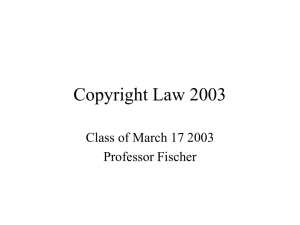Copyright
advertisement
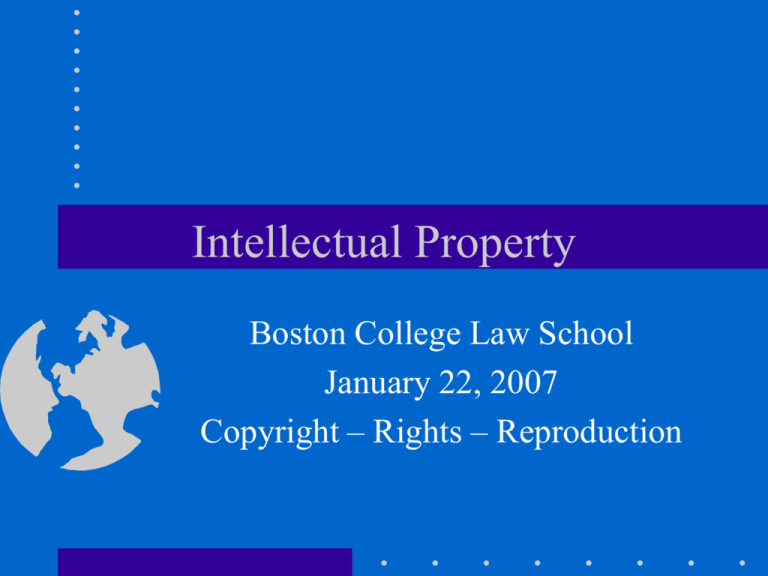
Intellectual Property Boston College Law School January 22, 2007 Copyright – Rights – Reproduction Rights of Copyright Owners • 17 U.S.C. §106 – “Subject to sections 107 through 122, the owner of the copyright … has the exclusive rights to do and to authorize any of the following: • • • • • • (1) to reproduce the copyrighted work … (2) to prepare derivative works … (3) to distribute copies … to the public … (4) … to perform the copyrighted work publicly … (5) … to display the copyrighted work publicly … (6) in the case of sound recordings, to perform the copyrighted work publicly by means of a digital audio transmission Right to Reproduce • Elements of infringement action – (1) Actual copying • Independent creation is not infringing • Factual issue for the jury – (2) Improper appropriation • Perspective is the ordinary observer • Did the copier copy “too much”? Bright Tunes v. Harrisongs Arnstein v. Porter Actual Copying Webber Striking Similarity Harrison BeeGees Similarity Arnstein Jury No Jury No Similarity Access Actual Copying • Methods of proof – Direct evidence – Circumstantial evidence • (1) Access • (2) Similarity • Procedural issues – Issue of fact: for the jury – Expert testimony is often permitted – Reviewed on appeal for clear error Improper Appropriation • Improper Appropriation – Standard: “substantial similarity” – Perspective: intended audience • Types of cases – Fragmented literal similarity • Literal copying of portions of original – Comprehensive nonliteral similarity • Non-literal copying of ideas, structure, plot, characters, etc. Nichols v. Universal • “Upon any work, … a great number of patterns of increasing generality will fit equally well, as more and more of the incident is left out. The last may perhaps be no more than the most general statement of what the play is about, and at times might consist only of its title; but there is a point in this series of abstractions where they are no longer protected, since otherwise the playwright could prevent the use of his ‘ideas,’ to which, apart from their expression, his property is never extended. Nobody has ever been able to fix that boundary, and nobody ever can.” Abstractions Test Not Protected Idea Plot Outline Subplots, Characters Specific Scenes Text Protected Nichols v. Universal Abie’s Irish Rose Not protectible No copying of protectible material No copying The Cohens and the Kellys Idea Plot Outline Subplots, Characters Scenes Text Shakespeare v. Laurents Romeo & Juliet ? Idea Plot Outline Subplots, Characters Scenes Text West Side Story Improper Appropriation • Substantive issues – Standard is “substantial similarity” – Both quantitative and qualitative – Generally look to “ordinary observer” • Sometimes modify if intended for a specialized market • Procedural issues – Issue of fact: for the jury – Expert testimony generally not permitted – Reviewed on appeal for clear error Steinberg v. Columbia Infringing? Copyrighting Styles Sampling Statutory Limits • Statutory limits on reproduction right – – – – – Public library exceptions Broadcast exceptions Compulsory licensing for musical works Audio Home Recording Act Fair Use Next Assignment • Finish II.E (sections 2 through 4)
